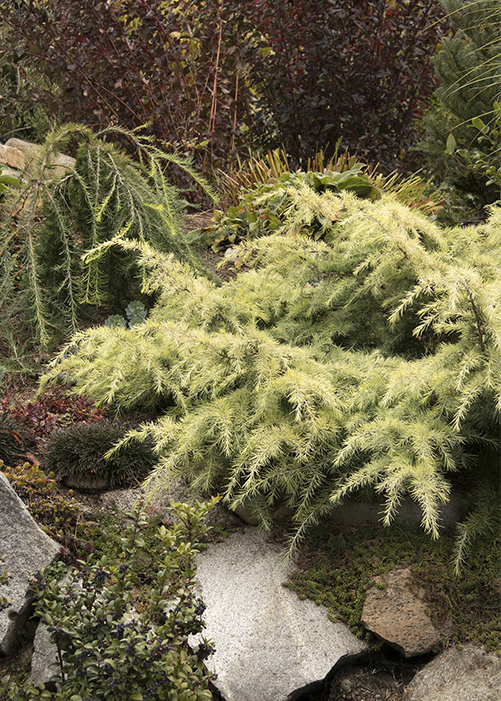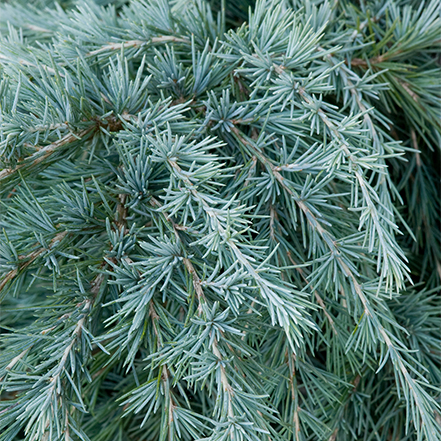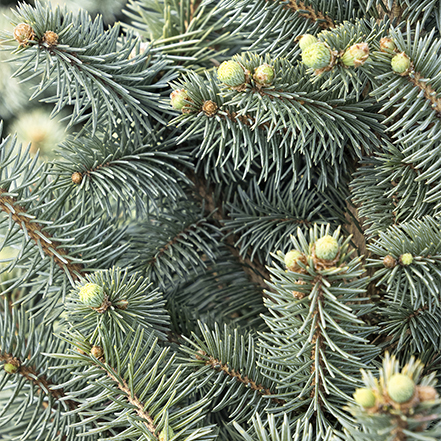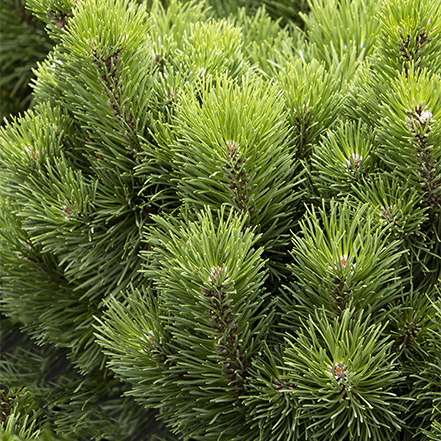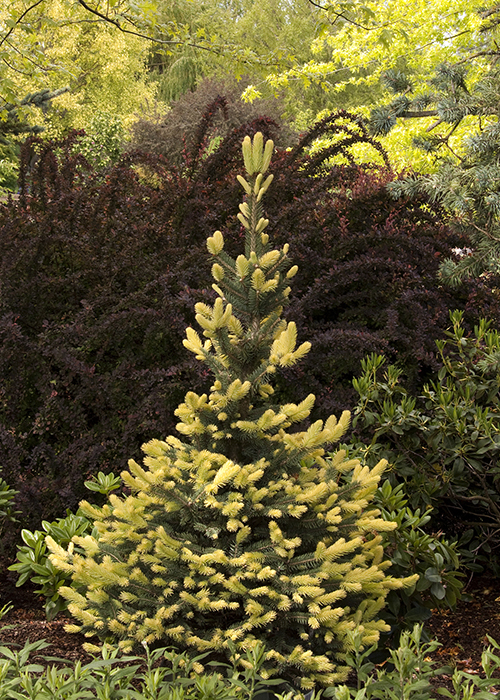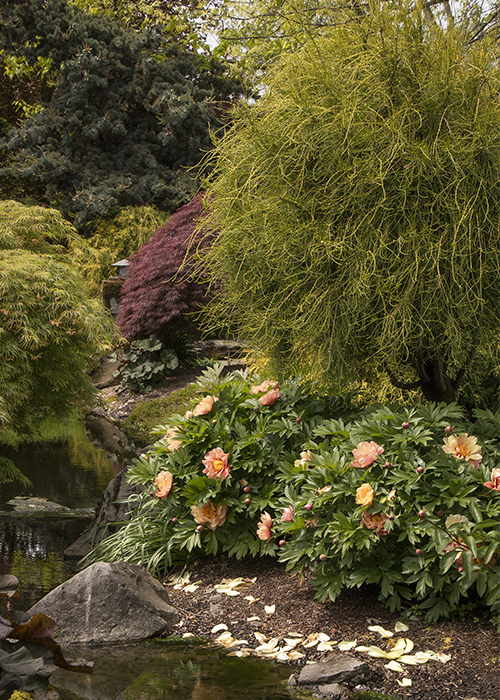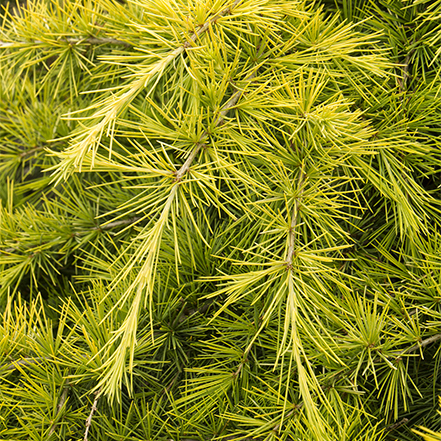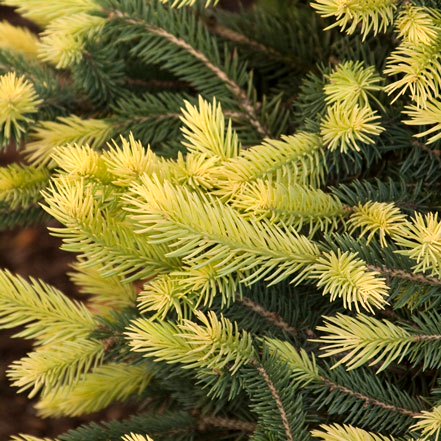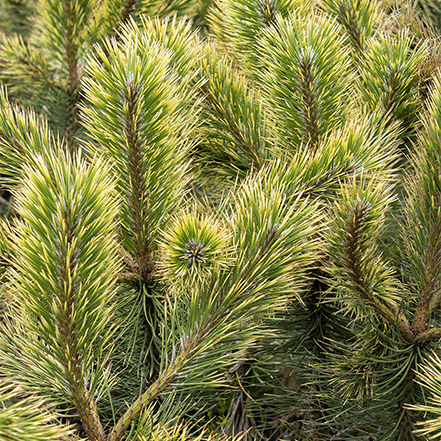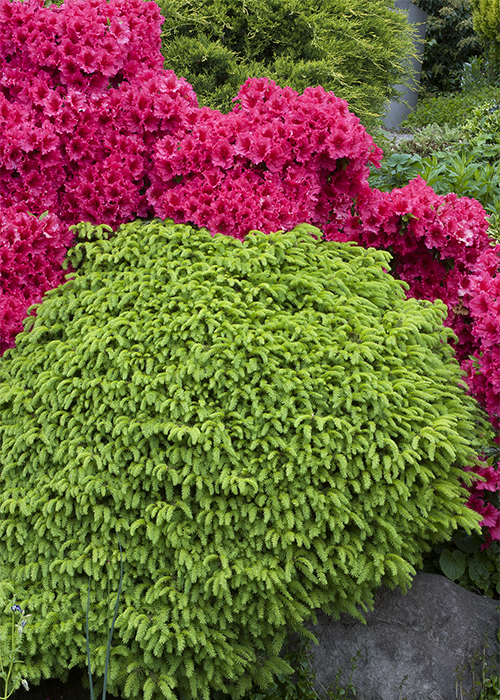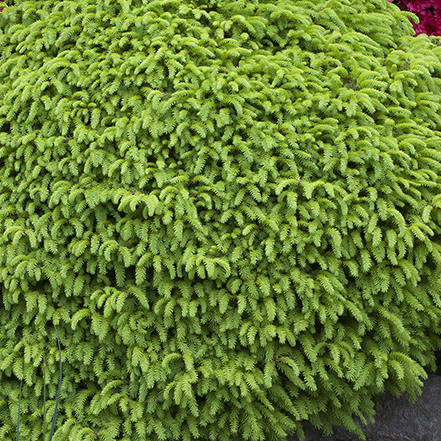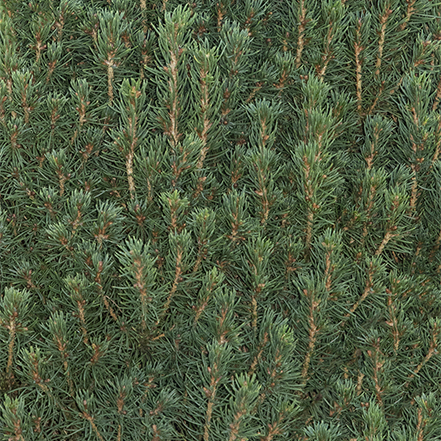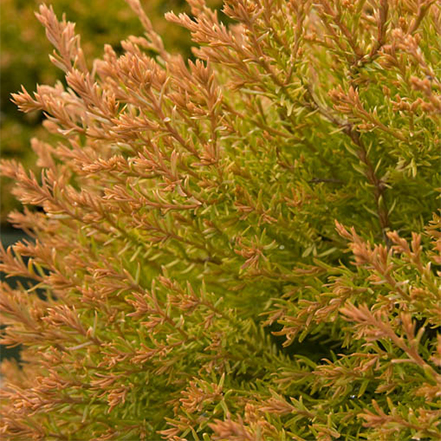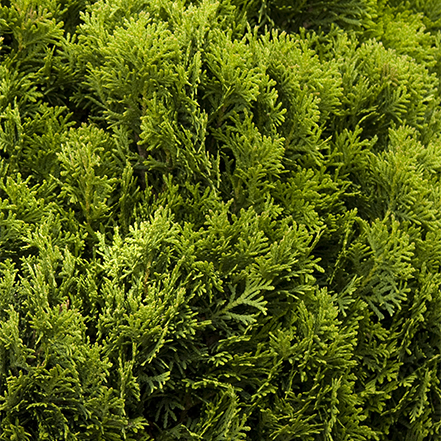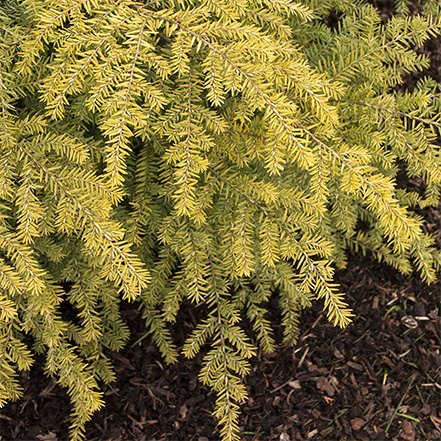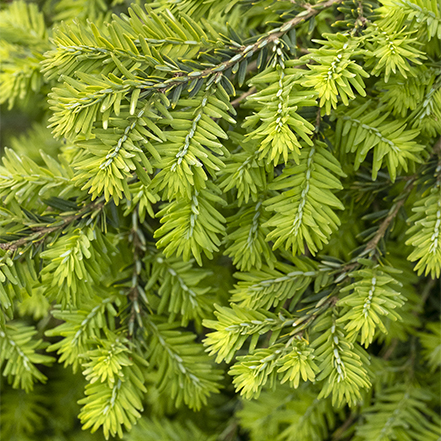The visual appeal conifers add to a garden. With their exciting shapes, color, and varied texture is most notable in winter when all else is bare. There is a conifer that will enhance every garden, from the small urban plot to one with acres to plant.
What is a conifer?
Conifers are woody trees or shrubs that grow their seeds in cones. Their leaves are called needles. While the needle-like foliage is present year-round or evergreen, not all conifers are always green.
Conifers offer rich shades of silvery blue, gold, orange, purple, and chartreuse. Many go through seasonal color changes. Bicolor conifers, with two colors on the same needle, can display variegated or patterned foliage. Often hanging like decorative ornaments, cones are produced in various colors and shapes.
Grow Confidently with Monrovia Conifers
Are you ready to find a versatile and attractive conifer for your growing zone? Begin your search right here with the outstanding selections offered by Monrovia. You'll notice it offers the best trees and shrubs in the industry. Look for the green Monrovia pot at your local garden center. This will hold conifer trees and shrubs. These have been expertly grown in custom soil until they are full, mature, and ready to thrive in your garden.
Want one that looks truly special? Seek out hand-crafted topiary forms. And note the difference that Monrovia's painstaking process makes. Topiaries in the green Monrovia pot have been hand-shaped for years. They will be fuller, with no brown or bare patches.
Read on for tips on why and how to plant, grow and care for conifers in your garden.
Growing and Caring for Conifers in the Garden
Conifers are easy to grow, extremely hardy, and adaptable in many climatic conditions. Conifers generally grow better in acidic soil. Many nutrients are unavailable to them when the soil is too alkaline.
Once established, they rarely need fertilizer and resist most insects and diseases. However, depending on your area of the country, some insect damage or disease may be more prevalent. Check with your county extension service for more details.
The most critical first step is to water correctly. Water when the soil is dry at a depth of 1-2 inches below the surface. This is especially critical in the first few years of growth. However, mature trees will need water during periods of drought to thrive.
Ecological Benefits of Conifers
Trees provide many environmental benefits due to their foliage. (I.e., rainwater absorption, pollution filter, wildlife cover, wind barrier, noise reduction, etc.). When deciduous trees drop their leaves in the fall, many ecological perks remain dormant until spring.
Conversely, with their canopy of evergreen foliage, conifers offer environmental benefits year-round. Choosing conifers that are well-suited to your local conditions contributes to helping balance your small part of the ecosystem.
The following are just a few reasons why planting conifers will improve your garden’s ecological footprint:
- Habitat for birds who don’t migrate to hide from the cold and protection from precipitation.
- A food source for many animals that eat the needles, buds, twigs, bark, and seeds contained in the cones.
- A conifer windbreak will decrease heating and cooling costs. This is by reducing cold air infiltration in winter and providing cooling shade in summer. While also shielding buildings and roads from drifting snow.
Find design inspiration and plant lists for your backyard habitat garden here. Sign up for the Monrovia newsletter to get our latest design guides with illustrated landscape plans.
3 Favorite Conifers for Wildlife Gardens
Feelin' Blue
Deodar Cedar
The lowest of the dwarf cedars, with a unique spreading form that rarely develops a leader. The intriguing form with blue-green foliage is a wonderful specimen for smaller spaces, rock gardens, and containers. Full sun. Up to 5' tall, spreading to 10' wide. Zones 6-9.
JeanGenie™ Colorado
Blue Spruce
The beauty of a classic Colorado Blue Spruce on a slower-growing plant, perfect for smaller landscapes. A handsome pyramidal form with a denser growth habit and brighter blue needles. Partial to full sun. Up to 15' tall, 8' wide. Zones 2-8.
Little Rick™
Mugo Pine
A gem among mugo pines. This compact, dense variety was selected at our Oregon nursery for its ability to stay green throughout the winter. Low maintenance and easy to grow. Full sun. Up to 5' tall and wide. Zones 4-9.
Expert Tips for Designing with Conifers
Pictured: Sparkler® Colorado Blue Spruce in the landscape with a Japanese Barberry
Pictured: Weeping Threadleaf Arborvitae, Misaka™ Peony, and Viridis Japanese Maple
Garden conifers offer a varied palette of colors, textures, and forms. They will be outstanding additions for decades. With careful consideration of their mature height and spread when placed in your garden. Make your plant selection based on the following factors:
- Function: the reason for choosing the plant, such as blocking an unwanted view or creating a windbreak.
- Form: the shape of the conifer will have an impact on the overall aesthetic.
- The right plant, right place: this principle encourages selecting a conifer that works with the natural ecosystem. In short, the plant must thrive in the USDA growing zone and the existing soil and light conditions. Other factors such as available moisture, pH, prevailing winds, and mature size should all be considered.
As a garden designer, I first choose the form that performs its function as beautifully as possible. Most of our gardens are not blank canvases but have existing features and conditions that we must integrate. Conifers have very strong forms that add interest, especially in winter. They can unify the garden design or create a backdrop for perennials and deciduous plants.
- A columnar form that is tall and narrow works well. Use as a hedging plant, visual screen, or planted singularly as a vertical accent (focal point) in the garden. Gray Gleam Juniper, Sky Rocket Juniper, and Yellow Ribbon Arborvitae are superb choices for this use in the garden.
- The pyramidal shape is wider at the bottom with a central trunk and often has horizontal branching. Pyramidal-shaped trees are generally more wind-resistant, like the striking Icee Blue® Yellow-Wood. The colorful and stunning Hoop’s Blue Spruce is a good choice for larger properties. The strong-rooted and virtually disease-free Green Giant Western Arborvitae thrives in warmer climates.
- Rounded forms can soften the sharp angles of a home’s architecture and outdoor structures and lend an air of formality. Dwarf Norway Spruce, with its spreading-rounded habit, can be a good cover-up for unsightly mechanical equipment. To obscure any undesirable features of your home’s foundation, plant Dwarf Scotch Pine or Danica Arborvitae. The rugged and adaptable Hetz Mini Arborvitae can be used in formal and modern-style gardens. It grows well in dry climates.
- Use spreading and mounding planted en masse, especially on slopes. Blue Pacific Shore Juniper is a very heat-tolerant plant that is a good choice for erosion control. Youngstown Andorra Juniper is a versatile ground cover that looks graceful, cascading over boulders or walls. Buffalo Juniper has excellent deer resistance and is easy to grow even in coastal conditions.
- Instead of growing straight up, the branches of weeping forms cascade beautifully to the ground. The weeping form is best used as a focal point. It can also be dramatic on a hillside combined with other shrubs. Tolleson’s Blue Weeping Juniper is tolerant of dry environments and makes a graceful background specimen or privacy screen. The unique, pendulous habit of Weeping Threadleaf Arborvitae can provide texture in a border planting. Sargent’s Weeping Hemlock shrub has finely textured foliage that thrives in both sun and shade.
3 Favorite Specimen Conifers
Feelin' Sunny®
Deodar Cedar
A stunning selection with bright, golden-yellow foliage. This unique dwarf cedar has an intriguing spreading habit that can be trained into upright or patio tree forms. Partial to full sun. Up to 12' tall, 8' wide. Zones 7-9.
Sparkler® Colorado
Blue Spruce
This distinctive new conifer heralds spring with bright yellow-gold new growth in stunning contrast to the mature blue-green foliage. Handsome pyramidal form with a dense, slower-growing habit. Full sun. Slowly reaches up to 60' tall, 20' wide with age. Zones 2-8.
Andean Gold™
Austrian Pine
A slower-growing, more compact Austrian Pine with showy yellow new growth that ages to light green. Tolerates poor soils, and harsh, drying winds. A showy conifer that's perfect as an eye-catching landscape specimen. Full sun. Up to 30' tall, 15' wide. Zones 4-8.
When and How to Plant Conifers
Across the country, the best time to plant is late winter or spring. (Early or late, depending on how far north you are.) Also, in early fall. Ideally, you want temperatures to be cooler and rainfall more plentiful. Conifers do need consistent, deep watering to get established.
Did you know? Staking your newly planted tree isn’t always necessary. Stake the tree if it's planted in a windy area. However, the stakes should be removed in six months to a year. Trees left to stand alone develop a stronger trunk.
(Pictured: Little Gem Norway Spruce contrasts beautifully with a pink rhododendron)
6 Steps for Planting Conifers
- Dig the hole shallow and wide, two to three times the width of the root ball. However, only deep enough for the root ball to sit 2 inches above the ground. A wide hole will allow for better root growth.
- Before planting, uncover the tree’s root flare—where the trunk expands at the base. This is so that you can ensure the flare is slightly above the soil surface. Planting too deeply will result in the declining health of the tree.
- Remove twine and burlap around the root ball and trunk to aid healthy root growth. Once the root ball is set correctly in the hole, remove the wire basket or cut it. This is so it will not interfere with root growth. Inspect the tree for circling roots and cut or remove them. Then spread roots outward in the hole.
- Fill the hole with the native soil. Gently tamp as you go to stabilize the root ball and eliminate air pockets. There usually isn’t any need to add organic amendments to the planting hole.
- Mulch around the root ball to a depth of about 3 inches, and keep mulch away from the trunk. Mulch will help keep roots cool in summer and warm in winter and help retain water.
- Water, water, water. Arguably the most important step. The one most people have issues with, is watering conifers deeply until they are established. Water your newly planted conifers deeply at least once a week until they are established, which can take two years.
When, How, and Why to Prune Conifers
The pruning needs of conifers are minimal if plants are chosen to fit their allotted space. A conifer should always be pruned for a particular purpose. Most pruning is best done in late winter or early spring. However, it's ok to remove dead and diseased parts and crossing branches at any time of the year. This will maintain the health and look of your conifer.
Your goal is to prune so that nobody can tell. Learn the pruning requirements of your specific species before making your first pruning cut.
Conifers fall into two groups determined by their branching pattern; whorl-branched and non-whorled or random branching.
Fir, Cedar, Cryptomeria, Spruce, and Pines are all whorl-branched conifers. The new branch growth occurs in spring and comes from the buds at the tips of the branches. Their natural shape requires little pruning but consider the following before making your first pruning cut.
- Pruning to control growth and keep its natural form is best started when the plant is young.
- The new growing tips are called candles. In mid-spring, the long, cylindrical candle tips will have elongated to 2-4 inches. To slow the growth, cut candle tips one-half to one-third.
- If you want plants to remain the same size, remove the entire candle when it gets about an inch long. (This pruning technique applies to conifers in containers and planted in the garden.)
- When performing other selective pruning, always cut back to a side branch or dormant bud. This is so that you will get regrowth. If pruning is done too late in the spring, buds will remain dormant, and no new growth will occur.
False cypress, Hemlock, Juniper, Arborvitae, and Leyland Cypress are in the non-whorl-branched group. These evergreens can tolerate more pruning.
- Pruning to maintain shape is best done in early spring so that new growth covers the cut ends.
- Hand pruning rather than shearing creates a more natural shape. But plants can be sheared in early summer once the tree stops growing. (If you want to encourage thicker growth or a custom shape.)
- Cut wayward or crossing branches to a side branch.
- Selectively prune individual branches of prostrate varieties rather than shearing the whole plant.
Avoid pruning both types of conifers in late summer or early fall. The tender new growth that forms afterward will not harden off before cold weather sets in. It will freeze and turn brown.
Your pruning tools should always be sharp. To prevent the spread of disease, disinfect your pruning tools with rubbing alcohol before using them.
Check out Adrian Bloom’s Gardening with Conifers, 2nd Edition, if you'd like to hone your conifer pruning skills.
Favorite Dwarf Conifers That Don't Need Pruning
Little Gem
Norway Spruce
Rich green needles form a dense, naturally flat-topped globe. This small, slow-growing evergreen requires practically no maintenance. A stunning accent or low-growing filler between larger conifers in borders. Partial to full sun. Up to 18" tall and wide. Zones 2-8.
Tiny Tower® Dwarf
Alberta Spruce
The dense, bright-green foliage and pyramidal form are perfect for smaller gardens and topiaries. Foliage matures to an attractive gray-green. Slow growing, up to 6' tall, 2' wide. Zones 3–8.
Fire Chief™
Globe Arborvitae
A nearly perfectly globe-shaped shrub with fine, bright gold spring foliage and fantastic deep red fall color. This sport of the popular Rheingold has deeper color and is less prone to splitting. Full sun. Up to 2' tall and wide. Zones 5-8.
Danica
Arborvitae
Versatile, dwarf, globe-shaped with bright emerald green foliage that turns bluish-green in winter. Smaller even than the popular Hetz Mini Arborvitae, it's an excellent choice for borders, foundation plantings, or low hedges. Up to 2' tall and wide. Zones 4–8.
Golden Duke®
Eastern Hemlock
A superb evergreen with glowing golden yellow foliage on graceful, upright, pyramidal arching branches. Improved sun tolerance over other gold hemlocks. Bright yellow-orange winter color. Partial to full sun. Up to 10' tall, 3' wide. Zones 4-8.
Emerald Fountain®
Canadian Hemlock
An excellent choice for a low-maintenance hedge or screen. Forms a densely branched, bushy column of evergreen foliage that requires little pruning. Retains its dark green foliage color throughout winter. Partial to full sun. Up to 10' tall, 3' wide. Zones 4-8.
Common Conifer Challenges
Conifers present differently, making them a bit of a puzzle to gardeners unfamiliar with growing them. Understanding how they’re different from other plants can help in caring for conifers so that they thrive. The following information addresses the most common concerns across growing zones.
Why is my conifer…?
- Losing needles: Some common conifers like yews and arborvitae will drop significant amounts of their inner foliage every 2-3 years. Most other conifers shed needles in cycles from summer through fall. A few conifers lose all their needles in one year, namely Dawn Redwood, Western Larch, and Bald Cypress.
- Have browning or wilting foliage with subsequent needle drop: can be caused by excessive heat, drought, and water stress. Most often, the remedy is proper watering. Don’t assume that in-ground irrigation is sufficiently watering trees and shrubs. Check for dry zones around your prized conifers.
Supplemental watering of established plants is beneficial during very dry months. Watering in the fall and winter is essential too. This helps to keep the roots moist once the ground freezes. Freezing temperatures can rob a plant of moisture and lead to winter desiccation. This damage often appears in early spring when needles appear yellow or brown.
It is often difficult to determine if a conifer is showing symptoms of infectious diseases or stress from environmental conditions. As mentioned previously, diseases of conifers vary by regions. Check with your local cooperative extension service for help with a diagnosis.
Learn More About Gardening with Evergreens
- Sign up for our Grow Beautifully newsletter. You'll get more design inspiration, garden tips, how-tos, and first access to exclusive plants.
- Use These Colorful Conifers to Transform Your Landscape
- The Best Dwarf Conifers Offer Big Solutions
- Best Evergreen Shrubs for Privacy
- How to Match the Best Evergreen Shrub to Your Landscape Need
- Colorful Cold-Loving Conifers for the Winter Garden
- Boxwood Winter Care
- Tips for Growing Pyracantha




